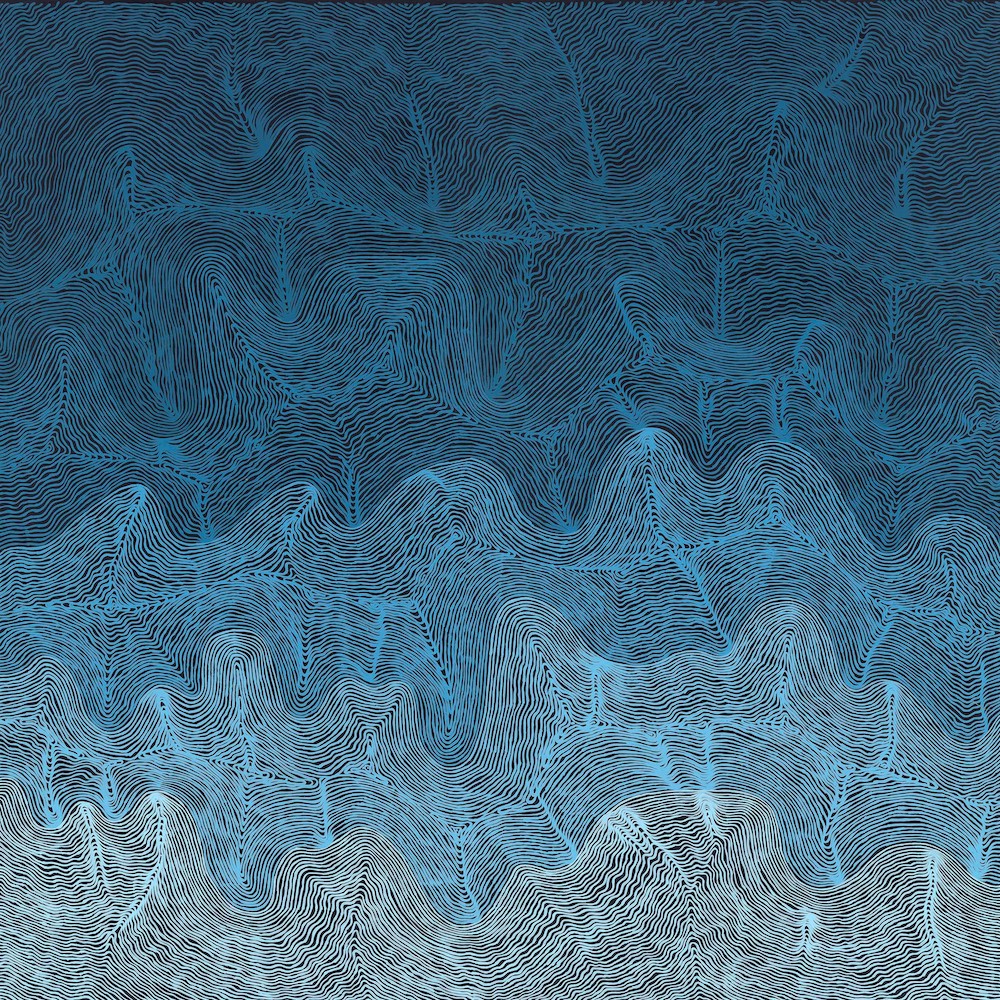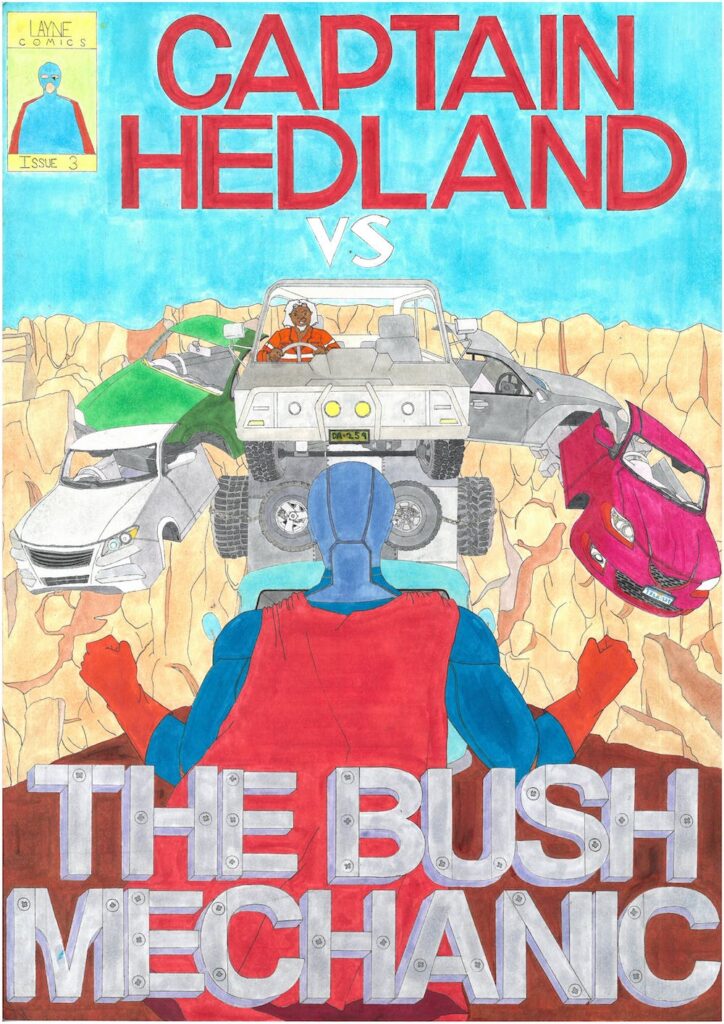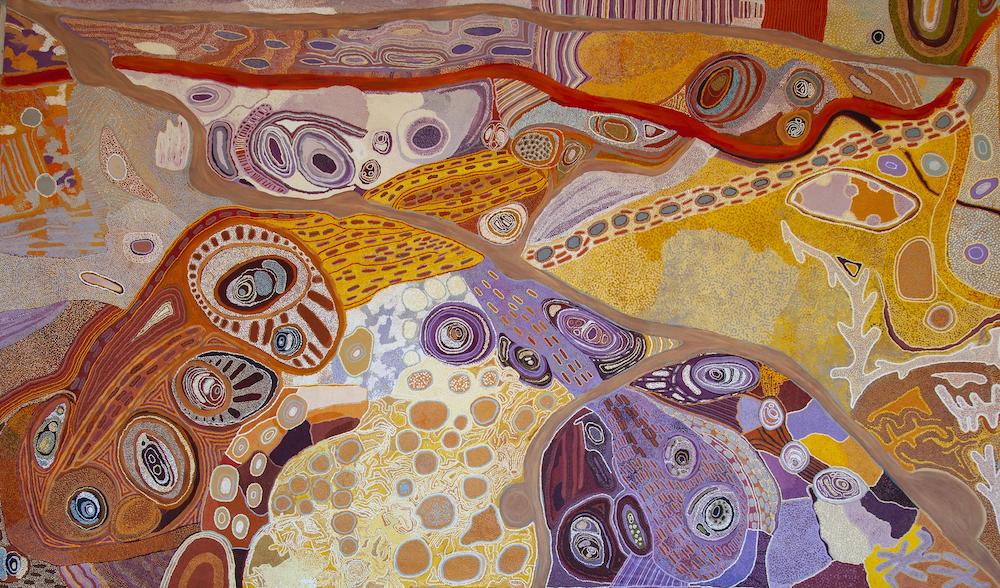“Tracks We Share” takes the viewer on a breathtaking journey through stories of the First Peoples of the Pilbara, discovers Craig McKeough.
Walking through Country together
1 June 2022
- Reading time • 8 minutesVisual Art
More like this
- A walk with Tina Stefanou
- A blaze of glorious people
- Diving into the gothic world of Erin Coates
“Tracks We Share”, FORM Building a State of Creativity and The Art Gallery of Western Australia; Aboriginal art centres Cheeditha Art Group, Juluwarlu Art Group, Martumili Artists, Spinifex Hill Studio and Yinjaa-Barni Art; and independent artists Katie West, Jill Churnside and Curtis Taylor ·
Art Gallery of Western Australia ·
The Pilbara region is known for its mineral wealth much more than its cultural treasures, but this is a perception West Australian creative arts organisation FORM has set out to challenge.
FORM has long-standing partnerships with Aboriginal arts centres in the Pilbara and has now drawn them together in the ambitious “Tracks We Share” project which culminates in a landmark exhibition at The Art Gallery of Western Australia.
Under head curator Andrew Nicholls, “Tracks We Share” champions the creative richness of the Pilbara through five of its Aboriginal art centres and through its acclaimed independent artists. The exhibition fills multiple gallery spaces with over 200 artworks from more than 70 artists, covering the “traditional” acrylic paintings on canvas as well as exciting explorations into different mediums and contemporary ideas.
The works on show are as diverse as the Pilbara landscape itself, perhaps challenging the idea of a single genre of “Aboriginal art”. This is art that spans a spectrum of styles and aesthetics and doesn’t sit neatly under any kind of generic label.

The exhibition is laid out so that visitors can follow a track through the region, from ocean to desert. Starting with mesmerising video work by Katie West, showing aerial views of the artist in the shoreline mangroves around Cossack, it moves through art from the three Roebourne-based centres – Juluwarlu Art Group, Cheeditha Art Group and Yinjaa-Barni Art – then along the coast to Spinifex Hill Studio at Port Hedland and inland to the desert communities represented by Martumili Artists in Newman.
There are many highlights along the way, including the visually lush paintings of Allery Sandy, with her layered, swirling images in a surprising range of colours. A neighbouring work by Aileen Sandy, Pilbara Rocks, employs an aerial perspective of country with wonderfully intricate linework on a massive scale. It offers a detailed impression of undulations in the land, while also cleverly mimicking folds in a huge bolt of fabric.
This painstaking detail is matched to stunning effect by Wendy Warrie with Hightide, a pair of large acrylic canvases, where Warrie uses a limited palette – one canvas in reds and the other blue – to represent movement of water over sand and rocks.
Martumili Artists’ contribution is big in number and scale and includes some impressive collaborative works, most of them bursting with colour. Outstanding among these are Karlamilyi and Kintyre (pictured below) – two stunning canvases which represent the Rudall River area of the east Pilbara, and which together issue a bold statement about First Nations connections and claims to land which has come under threat from mineral exploitation. These three by five metre paintings form a centrepiece of sorts to the whole exhibition in their style, subject matter and the inter-generational collaboration behind their creation.

The big picture presented by “Tracks We Share” is indeed very big, but there are many smaller treats to be enjoyed as the artists explore mediums including video, photography, animation and comic book art – the latter represented by young Spinifex Hill artist Layne Dhu-Dickie’s creations featuring the Indigenous superhero Captain Hedland.
Doreen Chapman (Spinifex Hill Studio and Martumili Artists), shows her quirky sense of humour with paintings of everyday life in town, including the all-important ATM. Her Spinifex Hill contemporary Nyangulya Katie Nalgood contributes a delightful collection of birds, painted in a simple but arresting style, capturing the movement and colour of the Pilbara’s avian populations.
There are darker elements, such as paintings by Yunkurra Billy Atkins (deceased) showing the terrifying cannibal spirit beings of Martu country, which are brought to quite gory animated life in a collaboration with Sohan Ariel Hayes. These are paired with Justice, by Curtis Taylor, an equally graphic, powerful sculptural work depicting tribal punishment.
Juluwarlu Art Group members, led by Michael Woodley and Wayne Stevens, worked together on the concept and creation of Ngundamurri, a beautifully shot and edited short video of a traditional ngunda (corroboree), which screens amid a collection of decorative masks and the work Jarniyjin (dancing sticks), a display of the carved sticks used in the ceremony (both pictured top). This feels like an intimate view into cultural practices stretching back thousands of years and right into the heart of the country itself – a real privilege for an outsider.
The scale and diversity of “Tracks We Share” is almost as breathtaking as the country it depicts. The exhibition and the wider project around it capture the shared purpose of the artists and art centres to preserve and strengthen their Country and culture.
You can’t help but come away with a renewed appreciation of the complexity of the land and a fresh impetus to experience more of it.
“Tracks We Share” continues at The Art Gallery of Western Australia until 28 August 2022.
A three day program of talks, tours and sharing with Pilbara artists and arts centres will take place 19-21 August at AGWA. Head to the AGWA website for program schedule and more info.
Pictured top: Tracks We Share Contemporary Art of the Pilbara Exhibition, ‘Ngundamurri’ (detail) by Juluwarlu Art Group

Like what you're reading? Support Seesaw.






